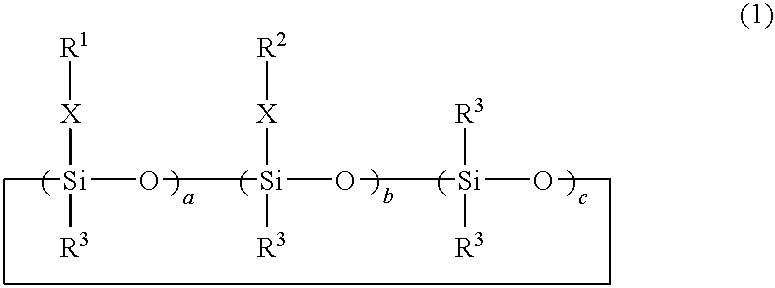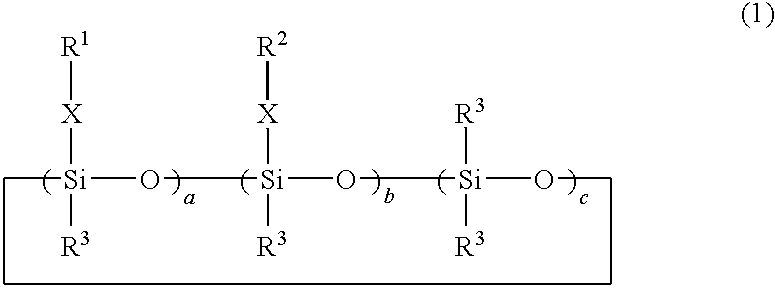Thermal conductive silicone composition
a technology of thermal conductivity and silicon, applied in the direction of group 4/14 element organic compounds, chemical instruments and processes, organic chemistry, etc., can solve the problems of oil bleedout, contaminating other parts/components on the printed circuit, and affecting the heat dissipation of electronic devices, so as to prevent the reduction of the curing rate and the heat resistance of the cured product. , the effect of reducing the heat resistance of the cured produ
- Summary
- Abstract
- Description
- Claims
- Application Information
AI Technical Summary
Benefits of technology
Problems solved by technology
Method used
Image
Examples
example 1
Comparative Example 1
[0035]A component A: a polydimethylsiloxane having a viscosity of 300 cP at 23° C. and containing vinyl groups at both terminals, 50 parts, component B: the hydrolytic polysiloxane represented by the following formula (B-1), 50 parts and component C: alumina (C-1) having an average particle diameter of 8 μm, 1200 parts, alumina (C-2) having an average particle diameter of 0.4 μm, 150 parts and alumina (C-3) having an average particle diameter of 0.2 μm, 150 parts, were kneaded by a kneader of a predetermined means to prepare a compound. Further, a component D: as a crosslinking agent, 0.16 parts of a methylhydrogen polysiloxane which has a trimethylsilyl group at both terminals and in which the side-chain part is constituted of 53 mol % of a methylhydrogen group and 47 mol % of a dimethyl group, a component E: as a reaction retarder, 0.03 parts of 1-ethynyl-1-cyclohexanol and a component F: as a curing catalyst, 0.016 parts of a vinylsiloxane complex compound pa...
examples 2 and 3
[0037]In Example 1, the ratio of the component A to the component B was changed to prepare a compound which is then evaluated in the same manner as in Example 1.
examples 4 and 5
[0038]A compound was prepared and evaluated in the same manner as in Example 1 except that, in Example 1, compounds represented by the following formulae (B-2) and (B-3) were respectively used as the hydrolytic siloxane as the component B.
[0039]
[0040]
TABLE 1Example 1Example 2Example 3Example 4Example 5Comparative Example 1Component A5080305050100Component BB-1502070———B-2———50——B-3————50—Component CC-1120012001200120012001200C-2150150150150150150C-3150150150150150150Component D0.160.220.110.160.160.16Component E0.030.030.030.030.030.03Component F0.0160.0160.0160.0160.0160.016ViscosityPa · s79023007607501250non-measurableState of thefluidfluidfluidfluidfluidcompound cannot becompoundpreparedThermal conductivityW / mK5.04.94.95.04.9—State of the cureduniformuniformuniformuniformuniform—productrubber staterubber staterubber staterubber staterubber state
[0041]As shown in Table 1, it was confirmed that in the case of the thermal conductive silicone composition containing a hydrolytic silox...
PUM
| Property | Measurement | Unit |
|---|---|---|
| particle diameter | aaaaa | aaaaa |
| particle diameter | aaaaa | aaaaa |
| particle diameter | aaaaa | aaaaa |
Abstract
Description
Claims
Application Information
 Login to View More
Login to View More - R&D
- Intellectual Property
- Life Sciences
- Materials
- Tech Scout
- Unparalleled Data Quality
- Higher Quality Content
- 60% Fewer Hallucinations
Browse by: Latest US Patents, China's latest patents, Technical Efficacy Thesaurus, Application Domain, Technology Topic, Popular Technical Reports.
© 2025 PatSnap. All rights reserved.Legal|Privacy policy|Modern Slavery Act Transparency Statement|Sitemap|About US| Contact US: help@patsnap.com



